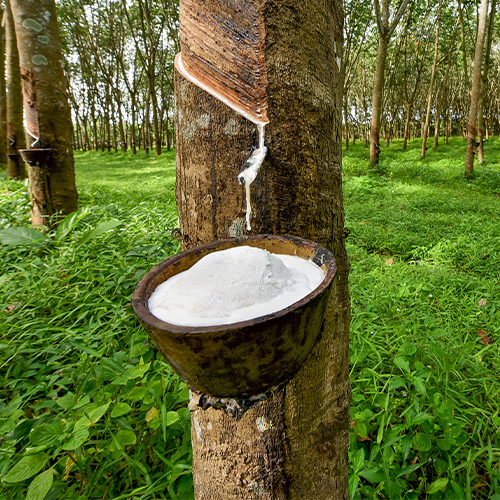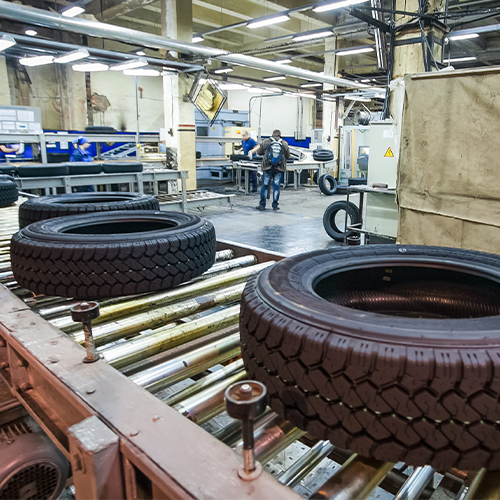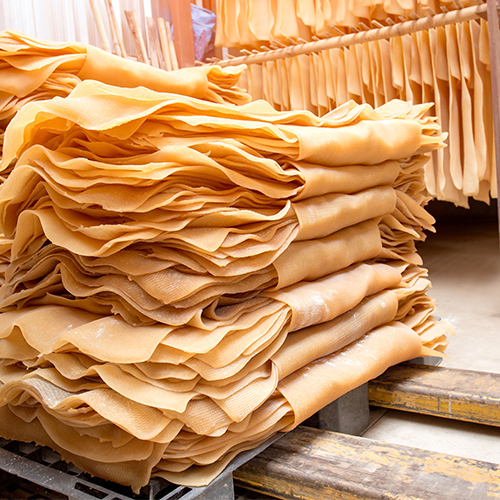
Posted on 10/02/2023 7:00:36 AM PDT by Red Badger
Today, you can buy tires that can carry your vehicle tens of thousands of miles. Modern tires are the results of decades of tire engineering progress. The tire compound is a versatile material that comes with a range of properties depending on the raw materials used to manufacture it.
These materials allow tire manufacturers to come up with detailed tire designs that stand the test of time and driving pressure. But what are tires made of? How to make tires that are actually durable in the long run?
There are some important physical and chemical properties at play that make vehicle tires safe for everyday use. One of the main feedstocks required in tire making is crude oil. Below, we are going to delve a bit into the tire manufacturing process.
We are going to show you how much oil they need to produce a single tire and why. For this, we need to delve a bit into rubber production as well.
What are Car Tires Made of Exactly?
To put it simply, a tire is a flexible rubber casing made to fit the rim of your vehicle’s wheel. However, the structure is a bit more complicated than that. There is also a number of required materials to make a tire you can actually rely on.
The primary raw material needed in tire manufacturing is rubber. The industry produces natural and synthetic rubbers on a wide scale. Due to the huge demand for tires, there is a shortage of natural rubber all around the world. It became inevitable to produce increasing amounts of rubber artificially, resulting in synthetic rubber.
Carbon black is also an essential ingredient, used in a fine powder form. Tire factories use a lot of this fine black fluffy particle, which is why they store it in big silos. Other ingredients include various chemicals. Each of them improves certain performance characteristics depending on the type of tire they want to produce.
While the end product is a one-fourth synthetic rubber tire, it also contains polyester, steel, nylon, silica, pigments, waxes, and reinforcing chemicals. Below, we are going to show you how exactly they make rubber, both natural and synthetic.
Getting the Raw Materials Ready
Natural rubber
Back in the day when people started to produce rubber tires, there was no rubber tree plant shortage. They produced latex rubber from the liquid sap they extracted from these trees. Kundzu, oak trees, and poplars are the main sources of natural rubber.
They produce a volatile hydrocarbon liquid called isoprene, which forms the basic structural unit of the rubber. Cutting the bark and collecting the sap in a cup through a process called latex dripping. Then, they added ammonia to make sure the sap won’t solidify over time.

Rubber Tree
Next, they extracted the rubber by adding acid to the mix. After 12 hours, the resulting rubber compound was still wet, so they had to pass them through rollers and then hang them over racks. As the last step, they fold it into bales so that they can use them for tire production.
Synthetic rubbers
Thanks to chemistry, processing rubber is easier than ever in the tire-making industry. It is a great alternative to natural rubber, although its production requires lots of crude oil. This artificial rubber is made by linking polymer molecules together.
This is done in a laboratory called a chemical plant. The main ingredients are petrochemicals such as neoprene, which is made of hydrochloric acid and acetylene. Emulsion styrene-butadiene rubber or E-SBR is another great product of polymer chemistry.
It is one of the most commonly used general-purpose synthetic rubbers in the World. This rubber is the copolymer of styrene (25%) and butadiene (75%). To put it simply, the molecules of these two monomers are cross-linked through the vulcanization process, resulting in a strong structure.
Isoprene can be obtained by processing petroleum oil, resulting in pretty much the same volatile liquid hydrocarbon produced by trees. By combining isobutylene and isoprene, manufacturers can make butyl rubber as well. This is another type of synthetic rubber that comes with minimal gas and moisture permeability and outstanding shock absorption properties.
Carbon black
Carbon black is basically the main reason why we have black tires instead of white ones. It not only gives the tire its color but also helps with heat dissipation. It is a filler material that is produced at high temperatures.
They use combustion air, which is a source of oxygen to burn fuel, and burn it together with hydrocarbon fuel, which is oil or gas. The result is a chemical material in the form of a soft powder, as it is best to be used in small granules in tire making.
It is used to strengthen the tire’s structure and improve its certain characteristics. It protects against ozone and UV rays, boosts its abrasion resistance, and enhances tensile strength.
The Construction of a Tire
Now we finally know what is rubber made out of. We prepared the raw materials, but one question is still there: How are tires made? Well, tire manufacturers follow a strict protocol when it comes to tire assembly. We are still a couple of steps away from getting all tire components ready.
There are various types of tires in the market, yet they all go through a similar construction process.
Material Mixing
At this stage, they mix together all different raw materials. The rubber polymers and additives constitute a mix that varies in consistency throughout the various parts of the tire. The reason for this is simple. You want to emphasize versatile characteristics for passenger tires than for industrial tires.
There is a huge difference between winter and summer car tires as well. The rubber is not exactly the same, which is why manufacturers adjust their recipes accordingly.
Component Rubberization
The next part of the manufacturing process rubberizes the components that reinforce the tire. These include cables, steel belts, and textiles for the most part. Depending on the type of tire in the making, manufacturers use 10 to 30 different components for a single tire.
Even passenger tires need steel cord belt plies, jointless cap plies (nylon embedded in rubber), textile cord plies, an inner liner of butyl rubber, etc.
Tire Assembly
They assemble all the abovementioned components using various machinery, resulting in “green tires”. At this stage, the tire gets its strong structure, although it still lacks the tread pattern. Assembly machines have their own belt drum where all components need to be placed.
It is where the tire gets its shape through stretching and pressing as all different parts come together.
Vulcanization
The rubber has to go through a process called vulcanization, which means that part of the process treats it with high heat. You can imagine this part as just throwing it in the oven for some time to cook it. It is the heat treatment phase that solidifies the structure.

Manufacturers usually do this part with sulfur, resulting in the molecules cross-linking with each other and forming a stronger bond. The heat makes the rubber compounds stronger and more durable. Once it is “taken out of the oven” it is ready for shaping, depending on the tread pattern and overall tire design.
How Much Oil Does it Take to Make 1 Tire?
We need about five gallons of oil to produce the synthetic rubbers required for a single tire. The whole tire manufacturing process that follows requires two additional gallons of oil. The manufacturing process uses it to fuel the energy required to prepare the materials and assemble the whole tire.
Bigger ones such as truck tires require, even more, averaging 22 gallons of oil. The tire industry often uses gasoline, the production of which also requires oil. For every barrel of oil (42 gallons), they can produce about 19 gallons of gasoline.
Can You Make Tires without Using Petroleum Oil?
The thing is that by making tires from natural rubber compounds instead of artificial ones, we do not take oil out of the whole equation. We still need it to produce the special additives needed to enhance the tire’s performance characteristics.
Moreover, we also need petroleum oil to work the tires into shape. Carbon black, one of the most essential ingredients is also a petroleum byproduct. It is produced through combustion, requiring various petroleum oil-based products in the process.
Tire manufacturers have already found a way to produce carbon black without burning oil. They have found ways to produce it from plant-based oil, methane, and carbon dioxide. However, they still need to somewhat rely on the petroleum-based method.
As technology advances, we are inevitably going to reach the point when brands can manufacture tires in an environmentally-friendly way. Until then, we more or less need to use petroleum oil in the process.
Can Rubber be Made Without Using Oil?
We can get the rubber from natural sources such as rubber trees. The real problem here is that there is a shortage of trees available, compared to the global demand for tires. The global manufacturing of rubber products has already contributed to mass deforestation across the world.
There are simply not enough natural resources to get the desired amount of rubber produced. Fortunately, science has found a way to produce isoprene, the main ingredient of rubber without having to use oil in the process. A company called Genencor had a project with Goodyear during which they found a way to generate natural isoprene.
They took plants such as corn cobs, switchgrass, and corn and used E. coli bacteria to break down their cellulose-based sugars. The result was natural isoprene and very few toxic waste products. This way, they have demonstrated an environmentally-friendly process.
They now call the end product BioIsoprene, which enables manufacturers to produce rubber compounds without using oil.
Is Rubber the Reason Why Tires are Black?
The reason why tires are black is quite simple. We have previously talked about what brands use to make rubber, and there is nothing black in it. The ingredient that makes tires black is carbon black, which brands add to the mix later in the tire manufacturing process. It is crucial for the tire’s abrasion resistance and tensile strength. Due to the resulting strengthened structure, this ingredient makes the tire last longer.

Without carbon black, tires made of natural rubber would be white in color. They would also have weak performance characteristics that would make them unsuitable for everyday use. It would result in short service life, wearing down tread patterns at a fast pace.
Friction – One of The Biggest Oil Consumers in the World
One of the biggest problems with tires is friction-induced pollution. You see, not all pollution comes from the tire manufacturing process. As you drive your car, your tires are constantly generating friction between the footprint and the road surface.
The result is plenty of tire dust that has a huge impact on the environment. As your tires grip the road, they dissipate energy and waste heat depending on their rolling resistance. When we do the math, it turns out that 9 percent of oil consumption is the result of tire rolling resistance. Low rolling resistance means less friction, less pollution, and fuel efficiency.
By making tires, tire manufacturers contribute to pollution by only 1 percent. We can only get that oil through oil refining, which generates hazardous wastes and pollutes our air and water as well. The devil is in the details, as they say.
FYI Ping!..................
Sounds like we need a law prohibiting EV’s from using Tires made wit5h any type of petroleum products to stay in the Green Zone.
Note that “tire dust” is high on the list of environmental bugaboos coming down the pike.
“Tire Dust Makes Up the Majority of Ocean Microplastics, Study Finds”
Tire dust has the magic property of being something you can’t see. In other words, the left can magnify it and make it sound like an invisible monster that not even our lying eyes can properly educate us on.
EVs eat tires because of their excessive weight, so more tires.
EVs also eat up roads for the same reason, so more ASPHALT, a petroleum product.
NEWSOME: “I’m gonna put BIG OIL OUT OF BUSINESS!”......................
Yeah, riiiight..........
Formula 1 has 10 teams, each with two cars — each car gets an allotment of 12 sets of tires every race weekend (plus rain tires if needed). Most of these tires are used up entirely each race weekend!
I love F1!
Just wait until they go full EV!...................
“Sounds like we need a law prohibiting EV’s from using Tires made wit5h any type of petroleum products to stay in the Green Zone.”
The end game for environmentalists is apparently some sort of pre-industrial lifestyle, except that using animals will not be allowed. Instead of oxen, humans will pull the plow. This is the future they look forward to.
Chainsaw math puts it at about one tankful of gas to produce 50,000 miles on 4 tires.
Just under 4 gallons of gas per tire. Seven gallons of crude produces 3.6 gallons of gas.
EC
I always say there's nothing stopping those Leftwing Loonies from living that lifestyle now, if they so choose. We already have entire groups of people living that way, and I recently watched that video of that Appalachian guy who lives completely off the grid. None of them ever really seem to want to do it, though...
Why stop with the tires? EVs are loaded with plastic which is made from oil.
This clearly makes anyone who thinks they are saving the planet by driving an EV a complete and utter moron.
Worth repeating...............
Then multiply by MILLIONS OF TIRES......................
Interesting article, but it’s written at a fourth grade science level. No wonder there’s no author listed.
The only solutions to tire pollution and energy consumption are 1) ban all vehicles or 2) reduce the earth’s population to one billion.
Well, maybe our betters will allow us to own private vehicles for a while because they can’t ban them outright. So you’ll find your 5,000 mile per year driving allowance won’t get you very far. After getting that camel’s nose into your tent, your betters will ratchet that down to 1,000 miles within a few years of adopting that near-ban on driving. Then down to 500 miles.
That’s Formula E — it exists and is boring...
Thay change cars 1/2 way through the race as they cannot be recharged...
> Then multiply by MILLIONS OF TIRES......................<
Then multiply by 50,000 miles……
EC
If natural rubber is white, why arent the tires white? What makes the “WHITEwalls” and the letters white? If I cant have a flying car I want one with white wheels.
Disclaimer: Opinions posted on Free Republic are those of the individual posters and do not necessarily represent the opinion of Free Republic or its management. All materials posted herein are protected by copyright law and the exemption for fair use of copyrighted works.